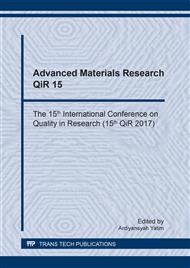p.109
p.116
p.121
p.128
p.136
p.142
p.150
p.158
p.171
Effect of Sub Zero Treatment on Microstructures, Mechanical Properties, and Dimensional Stability of AISI D2 Cold Work Tool Steel
Abstract:
AISI D2 tool steel has become important material in the industry, especially for mold and dies maker and also used for cutting tools. Conventional hardening process such as annealing and quenching is normally done for this kind of steel as it needs high hardness and wear resistance properties. To further improve its performance, sub-zero treatment can be performed. Quenching the steel in very low temperature e.g. liquid nitrogen, will help to remove unwanted retained austenite, thus provide better dimensional stability. In this study, AISI D2 tool steel samples were subjected to austenitizing temperature of 1030°C and then quenched using different quenching media i.e. air, oil, and liquid nitrogen. Vickers test result showed that after quenching process, the hardness for those samples were 762 HV, 822 HV, and 735 HV for air, oil, and liquid nitrogen quenched respectively. Microstructure analysis showed that retained austenite volume fraction after quenching process were 7.50%, 3.93%, and 3.18% for air, oil, and liquid nitrogen quenched respectively.
Info:
Periodical:
Pages:
136-141
Citation:
Online since:
August 2018
Price:
Сopyright:
© 2018 Trans Tech Publications Ltd. All Rights Reserved
Share:
Citation:


